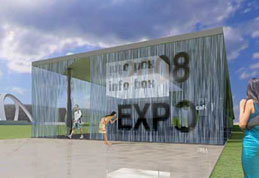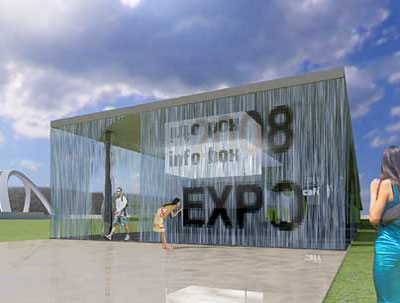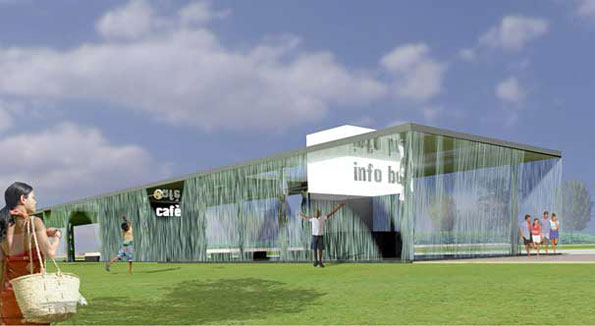NEWS
GENERAL

19 January, 2009
MIT architects design building with 'digital water' walls
Pavilion is set to make a splash in Spain. 

Patti Richards, News Office
Imagine a building made of water. It features liquid curtains for walls - curtains that not only can be programmed to display images or messages but can also sense an approaching object and automatically part to let it through.

MIT architects and engineers have designed such a building, and it will be unveiled at next year's international exhibition in Spain. The "digital water pavilion" - an interactive structure made of digitally controlled water curtains - will be located at the entrance to Expo Zaragoza 2008, in front of a new bridge designed by Zaha Hadid. The structure will contain an exhibition area, a cafe and various public spaces.

"To understand the concept of digital water, imagine something like an inkjet printer on a large scale, which controls droplets of falling water," explains Carlo Ratti, head of MIT's SENSEable City Laboratory.
The "water walls" that make up the structure consist of a row of closely spaced solenoid valves along a pipe suspended in the air. The valves can be opened and closed, at high frequency, via computer control. This produces a curtain of falling water with gaps at specified locations - a pattern of pixels created from air and water instead of illuminated points on a screen. The entire surface becomes a one-bit-deep digital display that continuously scrolls downward.
All of the walls of the pavilion will be made of digital water, as will vertical partitions, both on the edge of the roof and inside it. The pavilion roof, covered by a thin layer of water, will be supported by large pistons and can move up and down. When there is too much wind, the roof will lower. Similarly, when the pavilion is closed, the whole roof will collapse to the ground and the whole structure will disappear.
"Water, actuated by gravity, has traditionally been the most dynamic element in architectural and urban space," said William J. Mitchell, head of MIT's Design Laboratory and former Dean of Architecture at MIT. "For centuries, architects have shaped and directed it by means of channels and pipes, nozzles, and valves. The industrial era brought powerful pumps, which enabled larger-scale water elements, such as jets that spurted high into the air.
"Now, in the digital electronic era, new combinations of sensor technology, embedded intelligence, networking, computer-controlled pumps and valves, and control software open up the exciting possibility of urban-scale, precisely controlled, highly interactive water."
The facade of the water pavilion will be like a very large display, with text, letters, and interactive patterns. "You could throw a ball at the wall, and then see an open circle drop down to meet it precisely where and when its trajectory intersected the water surface. And, with suitable programming, touching the water surface at any point can propagate patterns horizontally, along the wall, to other locations," Mitchell explains.
Equipped with suitable sensors, Water Walls can detect the approach of people and, "like the Red Sea for Moses, open up to allow passage through at any point," said Mitchell. "This provocatively subverts the fundamental architectural conception of an opening as something, like a door, found at a fixed location."
The Pavilion illustrates the potential of "digital water" as an emerging medium. While there have been prior attempts to digitally control water droplets, this is the first time that the idea was used to create an architectural space. Since plumbing and electronics are not inherently expensive and recycled water is plentiful and cheap, water walls could conceivably be created on a large scale.
"The dream of digital architecture has always been to create buildings that are responsive and reconfigurable," said Ratti. "Think about spaces that can expand or shrink based on necessity and use. It is not easy to achieve such effects when dealing with concrete, bricks and mortar. But this becomes possible with digital water, which can appear and disappear."
Ratti added: "In the Nineties, digital technology led us to fantasize about distant virtual worlds. Today we have moved on: the future of architecture might deal with digitally augmented environments, where bits and atoms seamlessly merge."
The digital water wall concept was initially developed in the Zaragoza Digital Mile class at MIT, led by William Mitchell and Dennis Frenchman, with Michael Joroff and Carlo Ratti. The design of the Digital Water Pavilion was carried out by Walter Nicolino, Carlo Ratti, Claudio Bonicco and Matteo Lai at the architecture office carlorattiassociati (Turin, Italy); the engineering company Arup (London, UK and Madrid, Spain); and landscape architects Agence Ter (Paris, France).
More information and full credits can be found at www.digitalwaterpavilion.com.










